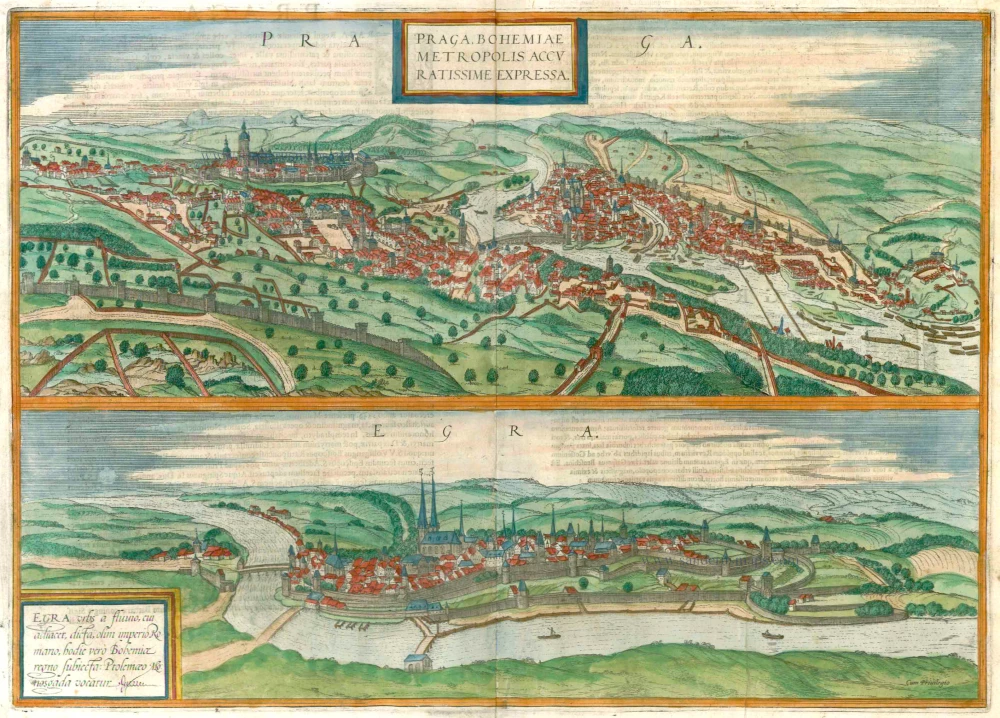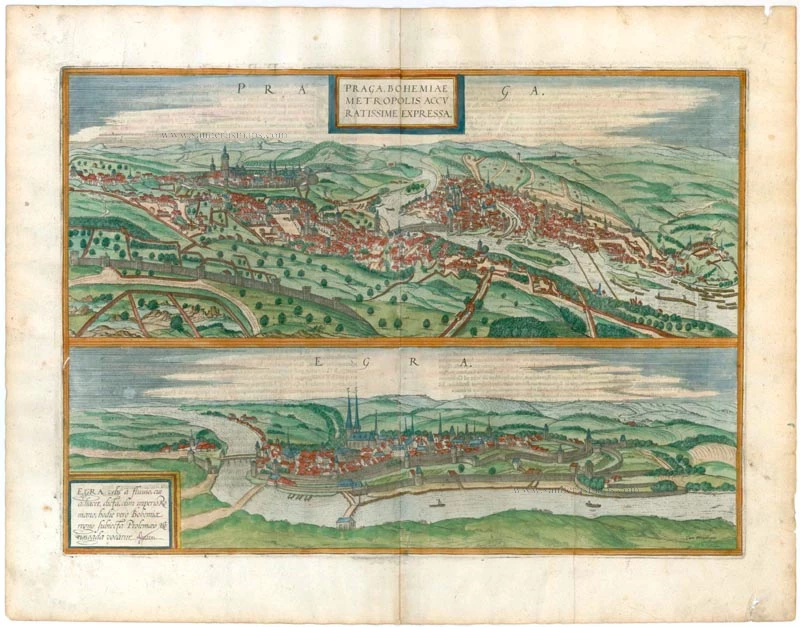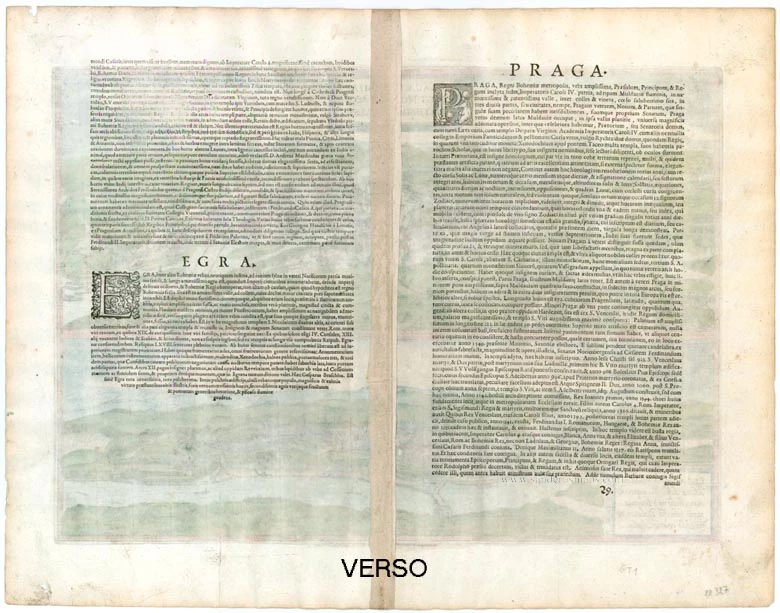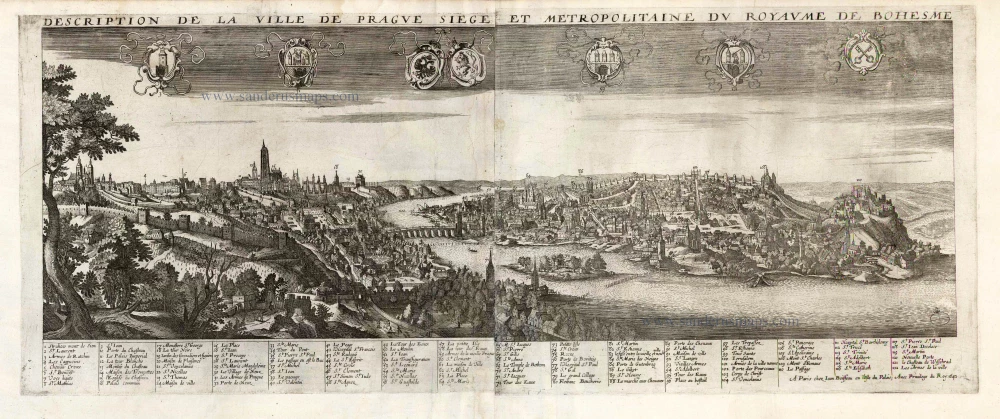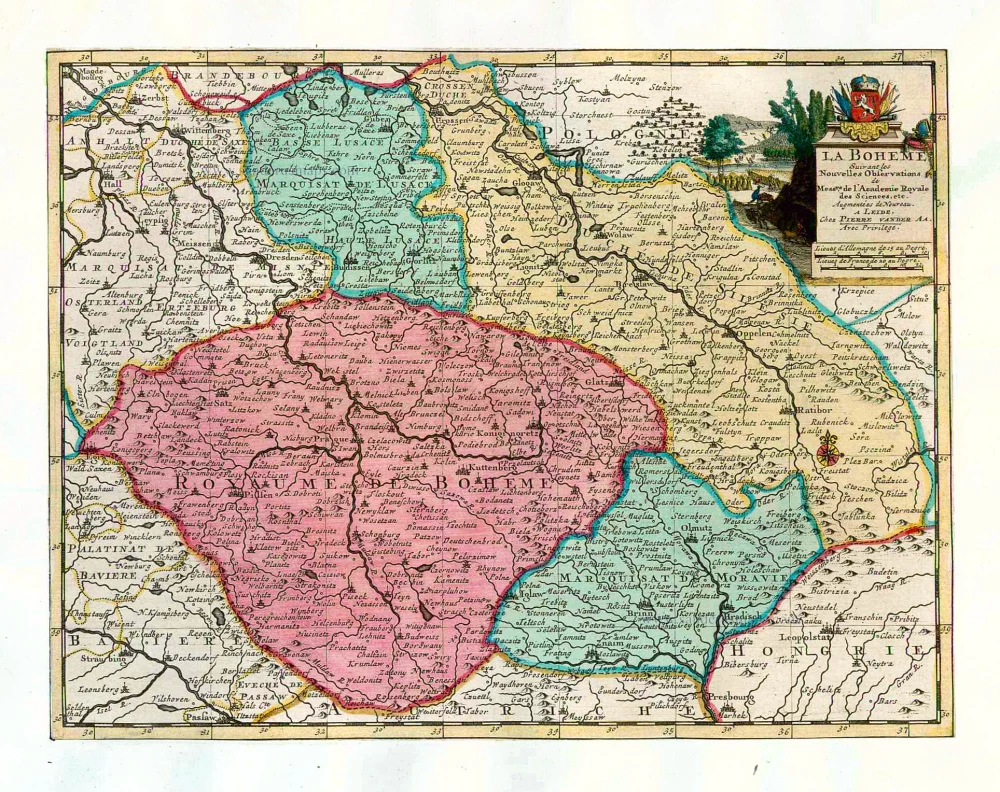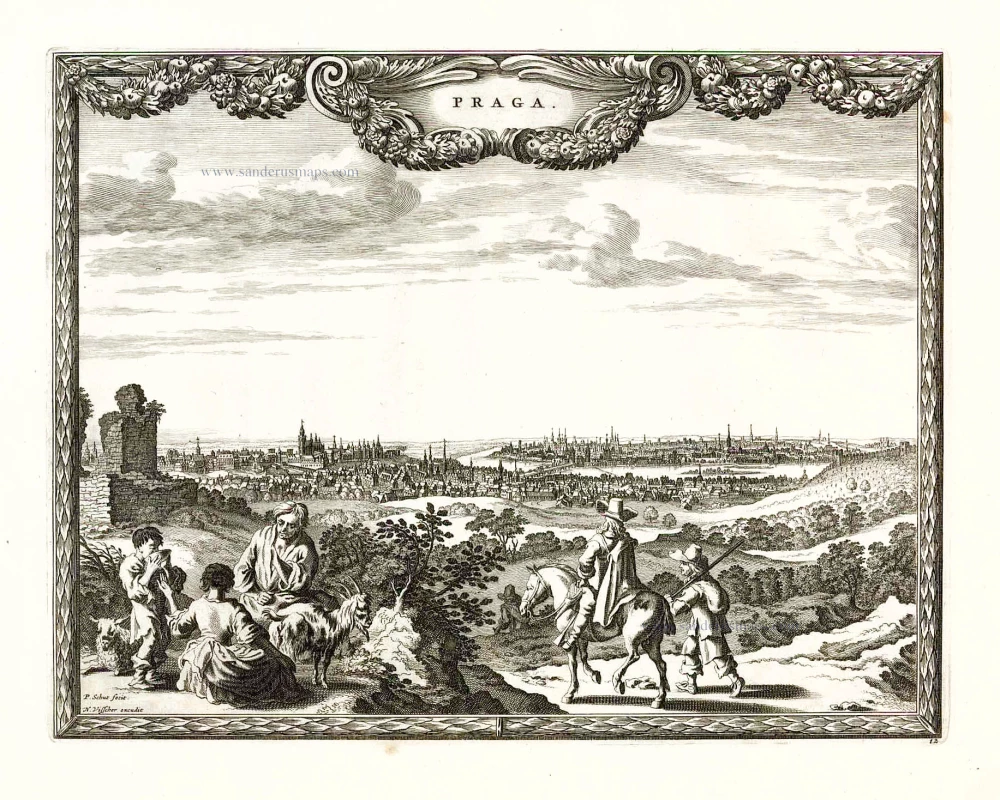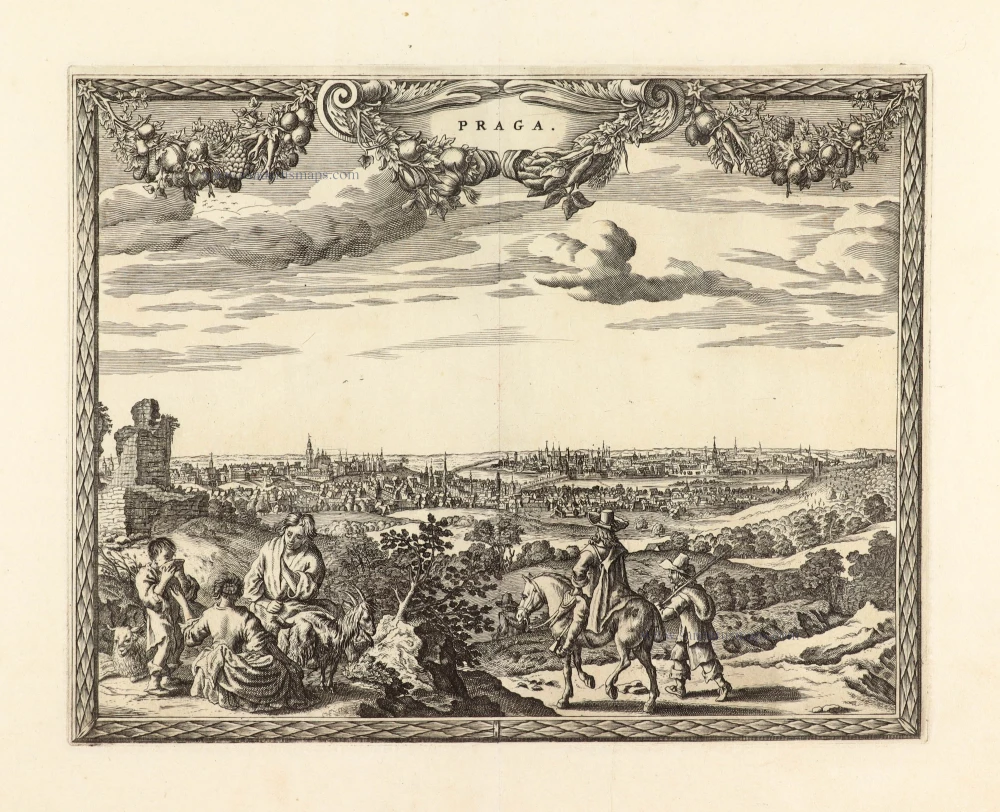Bohemia - Prague - Cheb, by Braun & Hogenberg. 1572-1624
PRAGUE (PRAHA)
CARTOUCHE: Prague, the capital of Bohemia, is most accurately portrayed.
COMMENTARY BY BRAUN: "Bohemia borders on Hungary to the east, Bavaria to the south, the Nordgau to the west. [...] The Elbe flows through the middle of this land but is eclipsed by the Moldau [Vltava], which flows through the noblest capital of the whole kingdom, Prague. Prague is a worthy royal and episcopal see, surely no less estimable than Florence. Prague is divided into three towns: Lesser Prague, Old Prague and New Prague. There is also a Prague university founded by the Bohemian king Charles IV, with a valuable library and magnificent university buildings."
The splendid first illustration of Prague shows the royal city from the southeast, in its natural setting in the Vltava Valley, which has cut its way deeply between the surrounding hills. On the left lies the all-dominating Hradcany castle complex from the 9th/10th centuries, beneath which is the Lesser Quarter (Malá Strana), linked to the Old Town (Staré Mesto) by the magnificent Charles bridge with its massive towers at each end. In the Old Town, the Gothic Teyn church with its twin towers can be recognized near the town hall. Above the Old Town and beneath the New Town (Nové Mesto) lies the old Jewish Quarter (Josefov). From the second half of the 14th century onwards, under Emperor Charles IV and his son Wenceslas IV, Prague was the capital of the Holy Roman Empire. Prague University, founded in 1348, was the first German-speaking university. By around 1600, Prague had 60,000 inhabitants, although its various districts were officially combined into a single metropolis as late as 1784.
CHEB
CARTOUCHE: Eger is named after the river on which it lies; it was formerly subject to the Roman Empire, today to the Kingdom of Bohemia; Ptolemy called it Monosgada.
COMMENTARY BY BRAUN: "Cheb, situated on very fertile soil between mountains and forests, is not the least significant town in Bohemia. It lies on a large river with the same name as the town and is navigable towards the south. The site also possesses a magnificent castle and a praiseworthy church of St Nicholas with two tall towers and other churches and monasteries."
The view from a cavalier perspective from the opposite bank of the River Ohre shows the well-fortified medieval town with its all-dominating imperial palace from the 12th century and the Gothic hall church of SS Nicholas and Elizabeth. Cheb was originally built as an imperial palace by Emperor Barbarossa and, in 1277, became an imperial city. Two important treaties were negotiated here: the Golden Bull of Eger of 1213, in which King Frederick II granted the German bishops the freedom to elect their own prelates, and the 1459 Peace of Eger, which determined the border between Bohemia and the Electorate of Saxony. (Taschen)
The view is made after a woodcut in Münster's Cosmographia, 1550.
Braun G. & Hogenberg F. and the Civitates Orbis Terrarum.
The Civitates Orbis Terrarum, or the "Braun & Hogenberg", is a six-volume town atlas and the most excellent book of town views and plans ever published: 363 engravings, sometimes beautifully coloured. It was one of the best-selling works in the last quarter of the 16th century. Georg Braun wrote the text accompanying the plans and views on the verso. Many plates were engraved after the original drawings of a professional artist, a professional artist, Joris Hoefnagel (1542-1600). The first volume was published in Latin in 1572, and the sixth in 1617. Frans Hogenberg created the tables for volumes I through IV, and Simon van den Neuwel made those for volumes V and VI. Other contributors were cartographers Daniel Freese and Heinrich Rantzau. Works by Jacob van Deventer, Sebastian Münster, and Johannes Stumpf were also used. Translations appeared in German and French.
Following the original publication of Volume 1 of the Civitates in 1572, seven further editions of 1575, 1577, 1582, 1588, 1593, 1599 and 1612 can be identified. Vol.2, first issued in 1575, was followed by further editions in 1597 and 1612. The subsequent volumes appeared in 1581, 1588, 1593, 1599 and 1606. The German translation of the first volume appeared from 1574 on, and the French edition from 1575 on.
Several printers were involved: Theodor Graminaeus, Heinrich von Aich, Gottfried von Kempen, Johannis Sinniger, Bertram Buchholtz and Peter von Brachel, who all worked in Cologne.
Georg Braun (1541-1622)
Georg Braun was born in Cologne in 1541. After his studies in Cologne, he entered the Jesuit Order as a novice. 1561, he obtained his bachelor's degree, and in 1562, he received his Magister Artium. Although he left the Jesuit Order, he studied theology, gaining a licentiate in theology.
Frans Hogenberg (1535-1590)
Frans Hogenberg was a Flemish and German painter, engraver, and mapmaker. He was born in Mechelen as the son of Nicolaas Hogenberg.
By the end of the 1560s, Frans Hogenberg was employed upon Abraham Ortelius's Theatrum Orbis Terrarum, published in 1570; he is named an engraver of numerous maps. In 1568, he was banned from Antwerp by the Duke of Alva and travelled to London, where he stayed a few years before emigrating to Cologne. He immediately embarked on his two most important works, the Civitates, published in 1572 and the Geschichtsblätter, which appeared in several series from 1569 until about 1587.
Thanks to large-scale projects like the Geschichtsblätter and the Civitates, Hogenberg's social circumstances improved with each passing year. He died as a wealthy man in Cologne in 1590.
Praga, Bohemiae Metropolis Accuratissime Expressa [on sheet with] Egra, Urbs a Fluvio ...
Item Number: 22327 Authenticity Guarantee
Category: Antique maps > Europe > Central Europe
Old, antique map of BOHEMIA - Prague - Cheb by Braun & Hogenberg.
Title: Praga, Bohemiae Metropolis Accuratissime Expressa [on sheet with] Egra, Urbs a Fluvio ...
Date of the first edition: 1572.
Date of this map: 1572-1624.
Copper engraving, printed on paper.
Size (not including margins): 335 x 475mm (13.19 x 18.7 inches).
Verso: Latin text.
Condition: Old coloured, excellent.
Condition Rating: A.
From: Civitates Orbis Terrarum, ... Part 1. Köln, 1572-1624. (Van der Krogt 4, 41:1.1)
PRAGUE (PRAHA)
CARTOUCHE: Prague, the capital of Bohemia, is most accurately portrayed.
COMMENTARY BY BRAUN: "Bohemia borders on Hungary to the east, Bavaria to the south, the Nordgau to the west. [...] The Elbe flows through the middle of this land but is eclipsed by the Moldau [Vltava], which flows through the noblest capital of the whole kingdom, Prague. Prague is a worthy royal and episcopal see, surely no less estimable than Florence. Prague is divided into three towns: Lesser Prague, Old Prague and New Prague. There is also a Prague university founded by the Bohemian king Charles IV, with a valuable library and magnificent university buildings."
The splendid first illustration of Prague shows the royal city from the southeast, in its natural setting in the Vltava Valley, which has cut its way deeply between the surrounding hills. On the left lies the all-dominating Hradcany castle complex from the 9th/10th centuries, beneath which is the Lesser Quarter (Malá Strana), linked to the Old Town (Staré Mesto) by the magnificent Charles bridge with its massive towers at each end. In the Old Town, the Gothic Teyn church with its twin towers can be recognized near the town hall. Above the Old Town and beneath the New Town (Nové Mesto) lies the old Jewish Quarter (Josefov). From the second half of the 14th century onwards, under Emperor Charles IV and his son Wenceslas IV, Prague was the capital of the Holy Roman Empire. Prague University, founded in 1348, was the first German-speaking university. By around 1600, Prague had 60,000 inhabitants, although its various districts were officially combined into a single metropolis as late as 1784.
CHEB
CARTOUCHE: Eger is named after the river on which it lies; it was formerly subject to the Roman Empire, today to the Kingdom of Bohemia; Ptolemy called it Monosgada.
COMMENTARY BY BRAUN: "Cheb, situated on very fertile soil between mountains and forests, is not the least significant town in Bohemia. It lies on a large river with the same name as the town and is navigable towards the south. The site also possesses a magnificent castle and a praiseworthy church of St Nicholas with two tall towers and other churches and monasteries."
The view from a cavalier perspective from the opposite bank of the River Ohre shows the well-fortified medieval town with its all-dominating imperial palace from the 12th century and the Gothic hall church of SS Nicholas and Elizabeth. Cheb was originally built as an imperial palace by Emperor Barbarossa and, in 1277, became an imperial city. Two important treaties were negotiated here: the Golden Bull of Eger of 1213, in which King Frederick II granted the German bishops the freedom to elect their own prelates, and the 1459 Peace of Eger, which determined the border between Bohemia and the Electorate of Saxony. (Taschen)
The view is made after a woodcut in Münster's Cosmographia, 1550.
Braun G. & Hogenberg F. and the Civitates Orbis Terrarum.
The Civitates Orbis Terrarum, or the "Braun & Hogenberg", is a six-volume town atlas and the most excellent book of town views and plans ever published: 363 engravings, sometimes beautifully coloured. It was one of the best-selling works in the last quarter of the 16th century. Georg Braun wrote the text accompanying the plans and views on the verso. Many plates were engraved after the original drawings of a professional artist, a professional artist, Joris Hoefnagel (1542-1600). The first volume was published in Latin in 1572, and the sixth in 1617. Frans Hogenberg created the tables for volumes I through IV, and Simon van den Neuwel made those for volumes V and VI. Other contributors were cartographers Daniel Freese and Heinrich Rantzau. Works by Jacob van Deventer, Sebastian Münster, and Johannes Stumpf were also used. Translations appeared in German and French.
Following the original publication of Volume 1 of the Civitates in 1572, seven further editions of 1575, 1577, 1582, 1588, 1593, 1599 and 1612 can be identified. Vol.2, first issued in 1575, was followed by further editions in 1597 and 1612. The subsequent volumes appeared in 1581, 1588, 1593, 1599 and 1606. The German translation of the first volume appeared from 1574 on, and the French edition from 1575 on.
Several printers were involved: Theodor Graminaeus, Heinrich von Aich, Gottfried von Kempen, Johannis Sinniger, Bertram Buchholtz and Peter von Brachel, who all worked in Cologne.
Georg Braun (1541-1622)
Georg Braun was born in Cologne in 1541. After his studies in Cologne, he entered the Jesuit Order as a novice. 1561, he obtained his bachelor's degree, and in 1562, he received his Magister Artium. Although he left the Jesuit Order, he studied theology, gaining a licentiate in theology.
Frans Hogenberg (1535-1590)
Frans Hogenberg was a Flemish and German painter, engraver, and mapmaker. He was born in Mechelen as the son of Nicolaas Hogenberg.
By the end of the 1560s, Frans Hogenberg was employed upon Abraham Ortelius's Theatrum Orbis Terrarum, published in 1570; he is named an engraver of numerous maps. In 1568, he was banned from Antwerp by the Duke of Alva and travelled to London, where he stayed a few years before emigrating to Cologne. He immediately embarked on his two most important works, the Civitates, published in 1572 and the Geschichtsblätter, which appeared in several series from 1569 until about 1587.
Thanks to large-scale projects like the Geschichtsblätter and the Civitates, Hogenberg's social circumstances improved with each passing year. He died as a wealthy man in Cologne in 1590.

